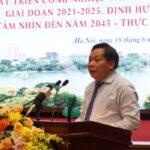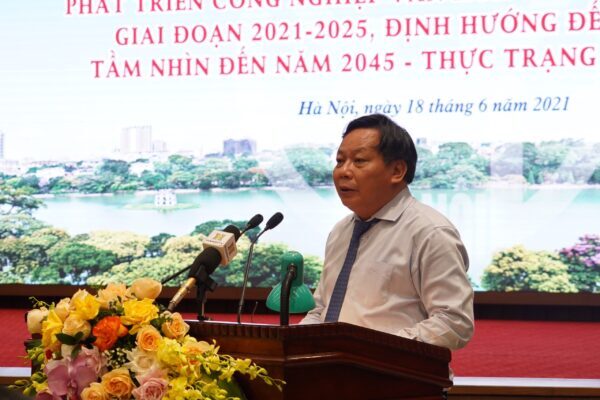
The Deputy Secretary of the Hanoi Party Committee, Mr. Nguyen Van Phong chaired the seminar
Seminar participants were the Deputy Secretary of the City Party Committee, Mr. Nguyen Van Phong, the Head of the Communication Department of the City Party Committee, Ms. Bui Huyen Mai, the Vice Chairman of the City People’s Committee, Mr. Chu Xuan Dung, the Director of the Hanoi Department of Culture and Sports, Mr. Tran The Cuong and leading representatives of the Central Communication Department, the Ministry of Culture, Sports and Tourism, the General Administration of Tourism, the Vietnam National Institute of Culture and Arts Studies, the Department of Culture and Arts, the Central Communication Department, the Vietnam Cinema Department and representatives several international organizations, including UNESCO in Hanoi, RMIT University Vietnam, representatives of some countries with developed cultural industries such as France, Italy, etc. specialists, experts, scientists and researchers in the field of cultural industry.
Speaking at the seminar, Ms. Bui Huyen Mai, Head of the Communication Department of the City Party Committee said: As the capital, Hanoi is currently converging to its fullest potential, development advantages, especially, Thang Long – Hanoi, the land of “Flying Dragons” is proud to be the convergence, crystallization and shine of national culture, “Capital of conscience and human dignity”, “Capital of heroes”, “City for Peace”, has a great treasure of cultural heritage, is the place to gather talents and wisdom of the whole country, at a time when the population structure is golden (over 51.7% of the young population), along with the strong integration process, international cooperation relations have been developed and expanded with more than 100 capitals and major cities in the world, which have created a new position and force in the international arena, creating momentum for the capital to develop quickly and sustainably.
That poses a great responsibility for Hanoi, how to truly deserve to be the typical major cultural center of the country, realizing the vision of becoming a major economic center, competitive domestically, regionally and internationally.
To achieve that goal and practically put the Resolution of the 13th Party Congress and the 17th City Party Congress Resolution into social life, Hanoi’s development perspective continues to determine and affirms potential and advantages in promoting cultural soft power, strengthening harmonious development between economy and culture, creating a new face and cultural environment, making Hanoi’s culture and people really become a great spiritual value, an important resource that decides the sustainable development of the Capital.
The City Party Committee decided to choose to develop the thematic resolution “Developing the cultural industry in the Capital area in the period of 2021 – 2025, orientation to 2030, vision to 2045” as a breakthrough in the development of the Capital’s culture with an open vision, in order to catch up with the trend of the times; constantly develop, improve the quality of culture, ensure the harmony between cultural preservation and development, improve the people’s spiritual life in association with narrowing the gap, improving the ability to enjoy culture between different regions (urban areas, suburbs, areas far from the center, etc.), making an important contribution to promoting economic growth, increasing the proportion of contributions to the City’s GRDP; towards the goal of sustainable development in each stage, striving to 2045 when Hanoi “has a high quality of life; comprehensive and sustainable economic, cultural and social development; and is a globally connected city with international competitiveness, GRDP/person is over 36,000 USD”.
This is both the concretization of the tasks set out in the “Strategy for the development of Vietnam’s cultural industry to 2020, with a vision to 2030” of the Government, as well as the high political determination of the City to fulfill its commitment to UNESCO in building Hanoi into a “Creative City” in the field of “Design” of Southeast Asia, with the foundation of creative cultural industries of the Capital.
In order to realize the development of cultural industries to become a spearhead economic sector, with remarkable development in both quality and quantity, contributing positively to the growth of GRDP in the Capital, achieving the goal of “Ha Noi becomes one of the three cultural industry centers of the country” in the Government’s strategy; creating a solid foundation, an important driving force to promote the construction of a “Creative City” in the coming time, in addition to opportunities and advantages, Hanoi City also realizes many difficulties and challenges such as: From the issue of globalization and international integration; context of the Fourth Industrial Revolution (4.0); digital transformation, development of digital economy and digital culture; unstable economic growth; rapid urbanization process; the mechanical increase in population is too high; in perfecting cultural institutions, mechanisms and policies; creative education and training in the fields of cultural industry have not updated the general development of the world; lack of coordination mechanism, cyclical and sustainable linkage between the fields of cultural industry; piracy in many creative fields is still going on; the developed cultural market is not commensurate with the potential and advantages…
At this scientific seminar, Hanoi wishes to receive intellectual contributions, enthusiastic consultation initiatives to build and develop the Capital from domestic and international experts, scientists, managers, businesses, artists, intellectuals and creative communities who are active in 12 areas identified in the Government’s Strategy for the Development of Cultural Industries, including Cinema; Performing Arts; Advertisement; Crafts; Software and entertainment games; Television and radio; Fashion; Cultural tourism; Architecture; Design; Publish; Fine Arts, Photography and Exhibitions.
Accordingly, this scientific seminar has received many opinions from international and domestic experts discussing the topics such as “Cultural dynamism”, urban regeneration and development of economy, education, creativity and innovation policies.
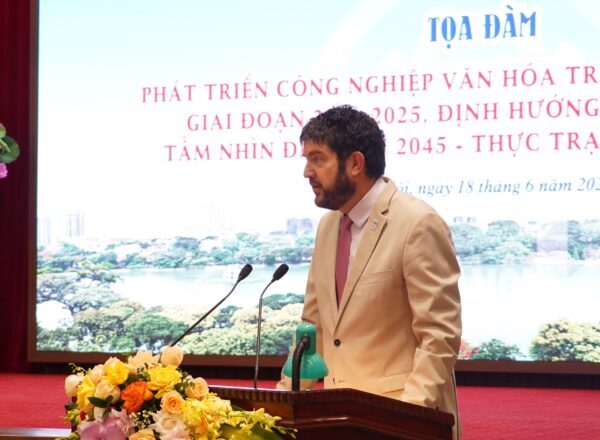
According to Mr. Michael Croft – the Chief Representative of UNESCO Vietnam at the seminar
According to Mr. Michael Croft – Chief Representative of UNESCO Vietnam: “Creative city” is a new story, contributing to making Hanoi the creative capital of Southeast Asia, the design field that Hanoi chooses contributes to creating a brand for Hanoi Capital.
After Hanoi successfully joined the Creative Cities Network, UNESCO worked with city leaders and the central government to realize Hanoi’s vision of becoming a Creative Capital. UNESCO, in collaboration with partners UN Habitat, UNIDO and with the support of SOVICO Group, has developed the project “Cultural resource mobilization and youth participation for Hanoi’s Creative Capital” with the slogan “Rethink Hanoi”.
This initiative will help drive a new strategic vision for Creative Capital – a city that empowers its citizens; Build a balanced, diverse and innovative economy and move towards a more sustainable, people-centred approach to development. The connection and cooperation help the Capital develop, in which young people should be placed at the center.
Assoc. Prof. Dr. Nguyen Thi Thu Phuong, Deputy Director of the Vietnam National Institute of Culture and Arts Studies assessed: Hanoi is a city that is rich in resources and potential for cultural industry development. The policies implemented by the City in the past time have initially created an institutional framework that is capable of promoting the 8 pillars of cultural soft resources. The dynamism of the cultural industries motivates Hanoi to become the first creative city in Vietnam to join UCNN in the design field. However, Hanoi also faces many challenges, namely: policy barriers prevent the cultural industry from really promoting its full potential and strengths of cultural resources. Hanoi also has not created an effective synchronous mechanism in developing the cultural industry, according to which Assoc. Prof. Dr. Nguyen Thi Thu Phuong proposed, if Hanoi wants to effectively promote cultural soft power, it needs to focus on investing in infrastructure development, science and technology for the development of cultural industries, creating traditional between modern connections in products; creating a mechanism for financial investment and capital attraction, forming an ecosystem that promotes creativity, and at the same time implementing the action plan that Hanoi has committed to with UNESCO’s network of creative cities.
Speaking at the seminar, Mr. Emmanuel Cerise, Representative of Île-de-France Region (France) in Hanoi said: Hanoi has a lot of potential for cultural industry, not only concentrated in central urban areas, Hanoi should expand investment in the periphery around the capital such as: Developing the Red Riverside area into a cultural space axis with river tourism and riverside eco-tourism. Craft villages on the outskirts of Hanoi can become bases for developing creative design products. Religious and cultural relics in the suburbs of Hanoi are the basis for developing tourism products to serve domestic and international tourists. Therefore, Hanoi should aim to establish sightseeing routes connecting many tourist sites to create cultural stories from the central area of the Imperial Citadel of Thang Long to the Old Quarter and craft villages, cultural relics.
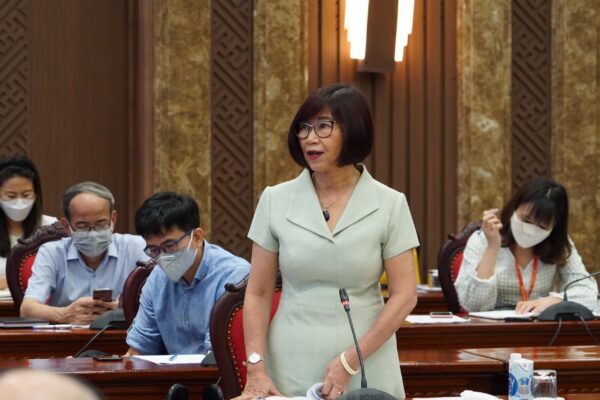
Dr. Le Thi Minh Ly, Vice Chairwoman of the Vietnam Cultural Heritage Association proposes some specific solutions
From the perspective of linking intangible cultural heritage with cultural industry development, Dr. Le Thi Minh Ly, Vice Chairwoman of the Vietnam Cultural Heritage Association proposed: Based on the community to create cultural products, creat contemporary heritage values, added values from heritage, Hanoi needs properly assess the heritage potential and promote the current heritage value in order to clearly orient the priority areas for investment in the cultural industry; continue to research, supplement, update and build database to manage, exploit and use cultural creativity; prioritize the production of heritage-based cultural products for the education of high school students; build ethical rules in the use of cultural heritage in the economy, socializing management and exploitation of heritage and relics with the content specified by international conventions and Vietnamese laws, especially the protection of cultural heritage, the rights and interests of cultural subjects (communities), cultural equality and license.
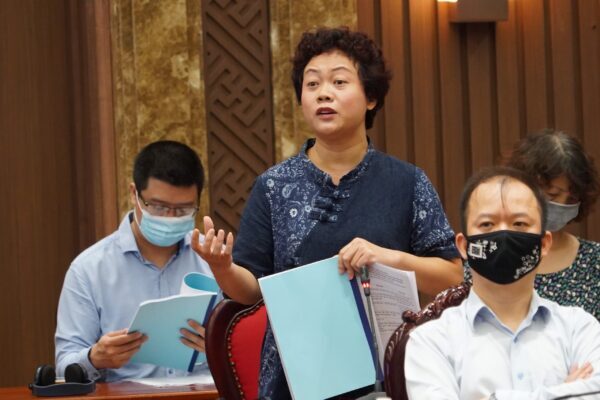
Assoc. Prof. Dr. Chu Cam Tho, Deputy Head of the Education Evaluation and Research Department – The Vietnam National Institute of Educational Sciences speaking at the seminar
According to Assoc. Prof. Dr. Chu Cam Tho, Deputy Head of Education Evaluation and Research Department – The Vietnam National Institute of Educational Sciences, People are the owners of creativity, the driving force for creativity to form and develop, and people are also objects that stay creative. Therefore, with the desire for sustainable creativity, we need to have creative citizens who master and elevate creativity starting from children who are educated creatively.
The seminar also received a speech from Mr. Antonio Alessandro, Italian Ambassador to Vietnam, about sharing experiences in implementing online exhibitions, inviting leading artists from other countries to cooperate; Mrs. Duong Hong Loan to RMIT University with the topic of training high-quality human resources; Mr. Nguyen The Son, Painter, Independent Curator and lecturer at the Vietnam University of Fine Arts with community art projects; Mr. Le Quang Binh, Team Leader of Network For a Liveable Hanoi with the idea of turning old factories into creative spaces; Mr. Nguyen Thanh Hung, Sovico Group with the development of cultural industry in the western axis of the city; Mr. Nguyen Minh Nhut, Director of the Department of Culture and Arts, Central Communication Department on selecting areas of strength for development…
Concluding the seminar, the Deputy Secretary of the City Party Committee, Mr. Nguyen Van Phong affirmed: Culture and cultural industry development are not only an important driving force for the sustainable development of Hanoi but also contribute to the sustainable socio-economic development, preserving traditional, long-standing and typical cultural values of Hanoi, and contributing to expanding international exchanges and cooperation in the field of culture. In particular, the development of the cultural industry helps to update the application of the industrial revolution 4.0, especially digital technology in the field of culture as well as other fields. With the changes in awareness, Hanoi wishes to continue to receive the consultation and cooperation of scientists, managers, writers, artists, intellectuals, domestic and international organizations. Hanoi is committed to actively seeking agencies and organizations with valuable models to offer cooperation and development, contributing to the capital’s cultural industry reaching out to countries in the continent and around the world.
Thanh Mai

